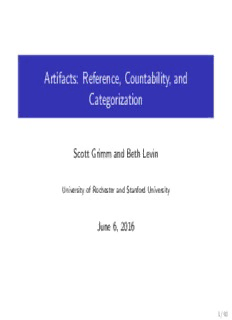
Artifacts: Reference, Countability, and Categorization PDF
Preview Artifacts: Reference, Countability, and Categorization
Artifacts: Reference, Countability, and Categorization Scott Grimm and Beth Levin UniversityofRochesterandStanfordUniversity June 6, 2016 1/93 The Puzzle of Furniture-Nouns Nouns like furniture might be considered mis(cid:12)ts at best, and spoilsports at worst! ▶ furniture, jewelry, luggage, mail, ammunition They cast doubt on the generalization that there is a mapping from countable nouns to individuals (e.g. dog, book) and from non-countable nouns to substances (e.g. water, mud). Why? They show a surprising combination of properties, which straddles mass and count. 2/93 The Puzzle of Furniture-Nouns ▶ Grammatically non-countable: A property shared with core mass nouns | liquids and substances (e.g. water, butter, sand, sugar): ▶ furniture/*furnitures, mail/*mails ▶ *two furnitures, *three mails ▶ water/*waters, gravel/*gravels ▶ *two waters, *three gravels 3/93 The Puzzle of Furniture-Nouns ▶ Individuals in their denotation: A property not shared by core mass nouns ▶ These individual entities are in principle countable ▶ Ed listed the furniture in the dining room. ▶ They are modi(cid:12)able (Schwarzschild 2006) ▶ big furniture distributes over the individual pieces ▶ They provide for a dimension of comparison (Barner & Snedeker 2005) ▶ If Ed has more pieces of furniture than Eva, then he may be considered to have more furniture. ▶ Hence, Barner & Snedeker’s (2005) label \object-mass" nouns, contrasting with the core or \substance-mass" nouns (See Deal 2016 for the many names given to furniture-nouns) 4/93 The Puzzle of Furniture-Nouns ▶ Individual constituents are often heterogeneous: A property not shared by core mass nouns, which are said to be homogeneous (in the non-technical sense) ▶ e.g. furniture may be comprised of a variety of types, each with their own names: chairs, tables, beds, sofas (cf. sand/grain of sand) ▶ Hence, nouns denoting the constituent entities may be used in their place { the furniture: John arranged the sofa, coffee table, chairs: ▶ This observation has not played a prominent role in past analyses 5/93 The Puzzle of Furniture-Nouns Key questions facing any account: ▶ What is in the meaning of furniture-nouns that allows them to have this puzzling conjunction of properties? ▶ Non-countable syntax ▶ Individual entities in their denotation ▶ Heterogeneity of these individuals 6/93 Previous Approaches The visibility of the constituent entities has prompted analyses in which the denotation of a furniture-noun is simply composed of these entities (e.g. Chierchia 1998, Bale & Barner 2009) ▶ It denotes a collection of individuals ▶ It is synonymous and co-extensive with its component parts \What else can the denotation of furniture be, if not all the pieces of furniture (down to the single ones)?" (Chierchia 1998: 68) 7/93 Previous Approaches Concomitantly, most formal treatments of the countability behavior of furniture-nouns are typically built on algebraic properties that make reference to the atoms in the denotations of nouns. ▶ Cumulativity, divisivity, homogeneity Among others: Bale & Barner 2009, Chierchia 1998, 2010, Rothstein 2010, Deal 2016 8/93 Our Proposal However, furniture-nouns are more than collections of entities: they have another important meaning component. Key to the analysis: furniture-nouns denote artifacts. ▶ Artifacts have a function and thus participate in some way in an associated event, e.g. furnishing for furniture The special properties of furniture-nouns follow from the type of associated event at issue: ▶ The associated event canonically involves the participation of multiple, and often diverse, entities Thus, furniture-nouns are artifactual aggregates (cf. granular aggregates such as sand, gravel, sugar) 9/93 Artifacts and Their Associated Events The artifact/natural kind distinction is an essential conceptual distinction among entities, as discussed by philosophers and cognitive and developmental psychologists. Among others: Aristotle, Wiggins 2001, Keil 1993, Wierzbicka 1985 10/93
Description: